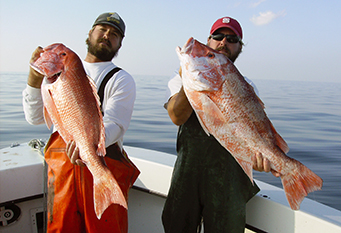When Gulf of Mexico red snapper was determined to be a fishery in precipitous decline, the public and federal attitude was that the commercial fishermen needed to fix it or lose everything. So they did — with an individual fishing quota program. And it really was just that: Some fishermen fixed it and some lost everything, as IFQs tend to go.
Seventh-generation Gulf of Mexico snapper fishermen David and Scott Floyd fish out of Pascagoula, Miss.Years later, the fishery is recovering, much to the joy of commercial fishermen who sacrificed years of fishing low quotas with the promise that as the biomass recovered, their quotas, too, would increase.
Now two pieces of legislation threaten to change all of that.
This week, Louisiana’s senators Mary Landrieu (D) and David Vitter (R) are making a strong push for a drastic and disastrous change to the federal fishery management system.
At the behest of frustrated sportfishing groups — the most vocal of which is the Coastal Conservation Association — many of the gulf states’ political leaders support handing control of the federally managed red snapper fishery to the states to manage individually.
Vitter’s move is an amendment to a bill designed to renew hunting and fishing programs; Landrieu is seizing the opportunity to present the change in a bill of her own. Both senators claim the 9-day 2014 sportfishing season for snapper was the straw that broke the camel’s back.
This isn’t the first time we’ve seen a fishery brought to its knees as a result of complicated and possibly draconian federal measures. It is, however, an unprecedented move on behalf of only one slice of the fishing stakeholders. Commercial fishermen would undoubtedly be left with the fuzzy end of the lollipop if this change takes place.
And this is after the gulf council surrendered to the CCA’s demands and voted to support significant changes in the way snapper quotas are allocated to the recreational sector. Instead of the longstanding and simplistic baseline of 49/51 for sport/commercial fleets, a preferred alternative would set a benchmark at 9.12 million pounds. Any quota above that benchmark would be allocated 75/25 for sport and commercial fishermen.
How is this fair to the commercial fishermen who worked so hard and sacrificed so much to bring the fishery back? What did the sport sector do to deserve such a windfall?
The message our politicians are sending is that when sportfishing is on the brink, the power dynamic shifts so that states opt to take control of federal fisheries. But when commercial fishing is threatened, it’s up to the fishermen to figure it out or go the way of the dodo bird.
This is quite possibly one of the worst end-runs around the fishery management system we have seen. But it’s not just a problem for the commercial guys. As long as the commercial sector gets handed the short straw quotawise, the dock price for snapper is likely to stay high and we’ll most likely continue to see seafood fraud on menus at restaurants whose purveyors can’t afford to source the premium fish.
In the end, the public will pay. They just might not see it right away.







